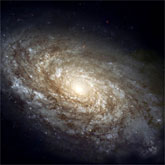From Here To There
 We all know that our galaxy, the Milky Way, is big -- very big. So big in fact that its size is impossible to grasp. To cope with the astronomical distances of galaxies, since miles or kilometers won't do, scientists have had to resort to using a really big yardstick. That yardstick is the distance light travels in one year, what scientists call a 'light year.' A light year is an obvious choice. It makes use of a concept that we are all familiar with, a year, the time it takes Earth to travel around our Sun. It also makes use of something that eats up a lot of miles, the distance light, traveling at 186,000 miles per second, covers in one year, 5 trillion, 880 billion miles or, approximately 6 million million miles.
We all know that our galaxy, the Milky Way, is big -- very big. So big in fact that its size is impossible to grasp. To cope with the astronomical distances of galaxies, since miles or kilometers won't do, scientists have had to resort to using a really big yardstick. That yardstick is the distance light travels in one year, what scientists call a 'light year.' A light year is an obvious choice. It makes use of a concept that we are all familiar with, a year, the time it takes Earth to travel around our Sun. It also makes use of something that eats up a lot of miles, the distance light, traveling at 186,000 miles per second, covers in one year, 5 trillion, 880 billion miles or, approximately 6 million million miles.
Now for some of you, the concept of a light year is familiar. But that's the point. It sounds familiar and tame to say that Alpha-Centauri, our nearest star, is 4.3 light years away. But if we add the zeros, we truly see how isolated we are, circling our Sun in our corner of the Milky Way. Alpha-Centauri is 25,000,000,000,000 miles from Earth.
Now consider that the most distant objects that we can see without a telescope are about 1.75 million light years away. There we go again -- big numbers. But that's a big number of something that already is a gigantic number. And that doesn't even take into consideration what the Hubble Space Telescope can see, distances of over 7 billion light years away. We are just now seeing light that left those distance realms in the early days of the universe. The universe is indeed a very, very big place.
About the Author
Gene Mascoli, JD
 Gene Mascoli is a founder and publisher of ScienceIQ.com. He holds a J.D. degree from the University of Santa Clara and a B.A. in English. In 1997 Gene launched ScienceMaster.com, an online science education portal where he brought together his love of writing with his interest in the sciences. Gene collaborated with David Gamon on the popular digital book
“The Internet Guide to NASA on the Net” and has also produced two popular science CD-ROMs on astronomy and space science.
Gene Mascoli is a founder and publisher of ScienceIQ.com. He holds a J.D. degree from the University of Santa Clara and a B.A. in English. In 1997 Gene launched ScienceMaster.com, an online science education portal where he brought together his love of writing with his interest in the sciences. Gene collaborated with David Gamon on the popular digital book
“The Internet Guide to NASA on the Net” and has also produced two popular science CD-ROMs on astronomy and space science.


